Rational nutrition is the basis of a healthy and fulfilling human life. A balanced, varied menu and food intake are important at any age, but are of particular importance during the growth and development of the child’s body. His well-being, mood and health will depend on how well a child’s diet is prepared.
Young children spend most of the day outside the home. In this regard, the most important task of the management is the competent organization of nutrition for children in kindergarten.
Our company believes that a child needs a large amount of nutrients for growth and development. Outdoor games, learning new things, active metabolic processes are accompanied by voluminous energy consumption. To restore these, the body needs regular balanced nutrition containing a sufficient amount of nutrients and water.
Organization of meals for children in kindergarten
Dishes acceptable for preparation in kindergarten are selected taking into account the age and daily needs of the child’s body. The menu is approved by the head of the institution for a period of at least 15 days. The products used for cooking are determined by the area of residence and nationality of the preschool children, as well as the presence or absence of health problems.
The meal plan includes breakfast, lunch, afternoon snack and dinner. In this case, breakfast should consist of a hot dish, a hot drink and bread. Lunch - first and second hot courses, drinks, snacks. The afternoon snack consists of a bakery product and a drink. Dinner includes hot food, salad and tea. If there is no product installed by the manual, an equivalent replacement is possible.
List of products recommended for use:
- Meat and fish products
- Boiled chicken eggs
- Milk products
- Vegetable and animal fats
- Confectionery
- Vegetable dishes
- Fruits
- Juice, tea, cocoa, compote
- Bread
- Salt
Prohibited for use:
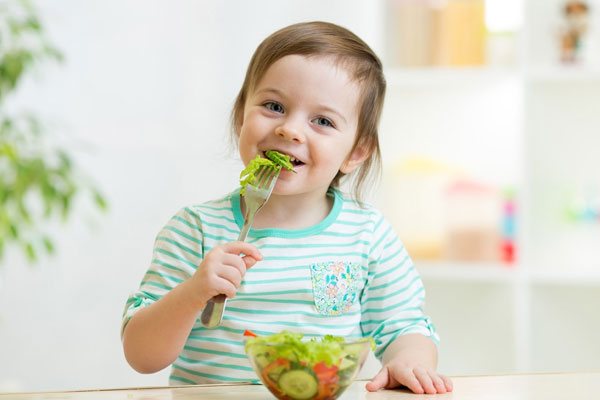
- Products without preliminary heat treatment
- Canned food
- Shellfish
- Confectionery with cream filling
- Drinks containing caffeine
- Drinks containing dyes and carbon dioxide
Before approving the main menu, a tentative list of dishes is drawn up. They are prepared based on culinary technologies and recipe books developed specifically for preschool institutions.
Parents are informed every day about the list of products served to children during the day. This obligation is fulfilled by the head of the institution by posting the daily menu in groups, indicating the names of dishes, the weight of portions and a list of replaced products (if some children have allergic reactions or other pathologies).
Guidelines for organizing catering in preschool educational institutions
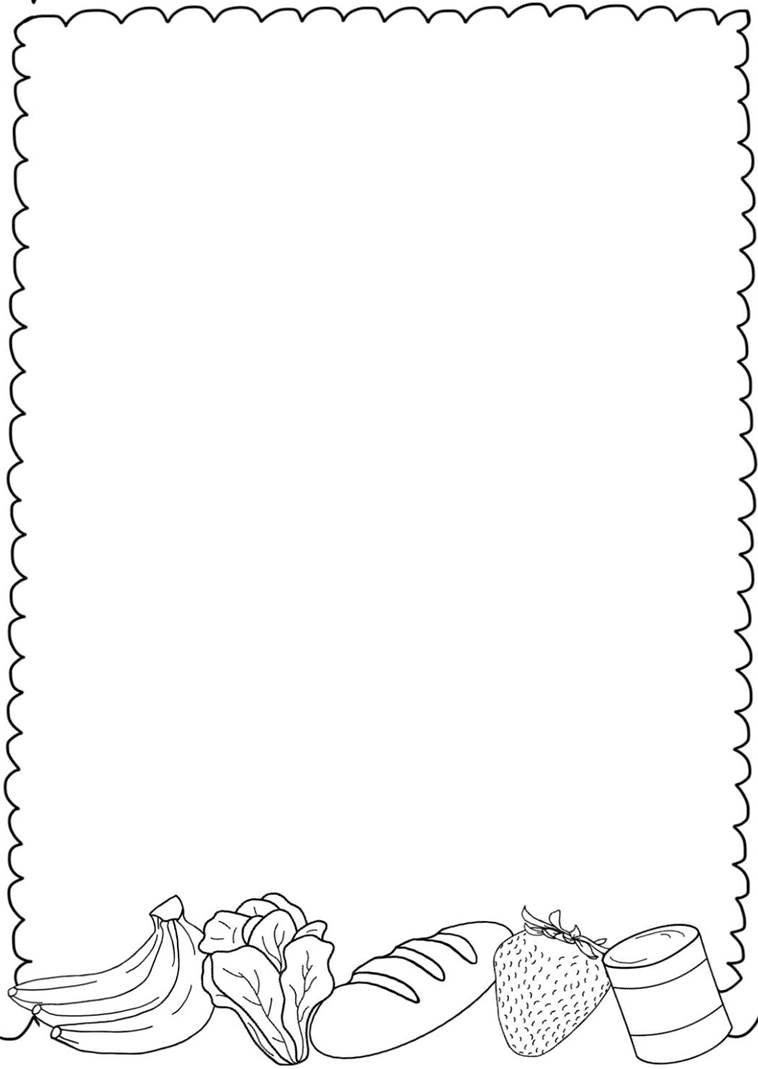
Methodological recommendations For normal growth and development of a child, properly organized nutrition is necessary.
A properly organized nutrition process promotes good absorption of food and has great educational value.
Good absorption of food depends not only on its taste and the child’s appetite, but also on his general condition, mood, and on the organization of the entire life of children in kindergarten. Before eating, a calm environment should be created in the group so that the kids are not tired or excited, so that they are in a good mood.
The routine in kindergarten is designed in such a way that long walks and noisy games end about half an hour before meals. This time is used for quiet games and activities. The teacher teaches children to sit at the table calmly and makes the necessary comments during meals quietly, in a friendly manner.
Beforehand, children put toys back in their places, wash their hands, and, if necessary, their faces. Those who eat more slowly wash their faces first; they sit down at the table and start eating without waiting for the others. Eating should only take place in a clean, well-ventilated room. The tables are arranged in such a way that it is convenient for children to sit down and stand up.
An important point in proper catering is good table setting. Experience shows that children like it when the table is covered with a white, clean tablecloth; Therefore, it is advisable to teach children to eat on individual cotton napkins from the very first days of their stay in kindergarten in younger groups.
Dishes should be age-appropriate, comfortable, pleasant in appearance, and uniform in shape and design. Forks need wide, flat, light, with four prongs. It is convenient for kids to use dessert plates and spoons. If compote or jelly is given for the third course, then they should be served in cups with saucers and spoons. Coffee, tea, milk are served not hot and without spoons, fruits are served on saucers.
There should be nothing superfluous on the tables that would interfere with taking bread, napkins, or placing plates.
There should not be long intervals in serving food, but short intervals are inevitable. Children of older groups sitting at the same table are allowed to talk quietly and exchange impressions at this time. During meals, tables must be kept in order. If any of the children accidentally spills food on the floor, they must wipe it up immediately. Children should be taught to be clean.
During meals, the teacher makes sure that the children eat their allotted portion. Children of younger groups need to be taught to take little by little, eat slowly, and chew their food. It is necessary to help children finish the portion, as small children's hands get tired quickly.
In the early days, you can let children hold the spoon and fork as they see fit. Subsequently, children learn to use cutlery: from 1.5 to 2 years old they eat with a spoon on their own, from 3 years old they use a fork.
When children learn to eat without the help of adults, the teacher shows how to hold a spoon and fork correctly: hold the spoon between three fingers, eat from its side; It is more convenient to hold the fork between the middle and thumb, holding it on top with the index finger, then it maintains an inclined, more stable position; if you take a side dish with a fork, it is turned with the concave part up and is used like a spoon.
While eating, they should lean slightly over the plate and chew silently with their mouth closed. If possible, you should use a handkerchief before eating.
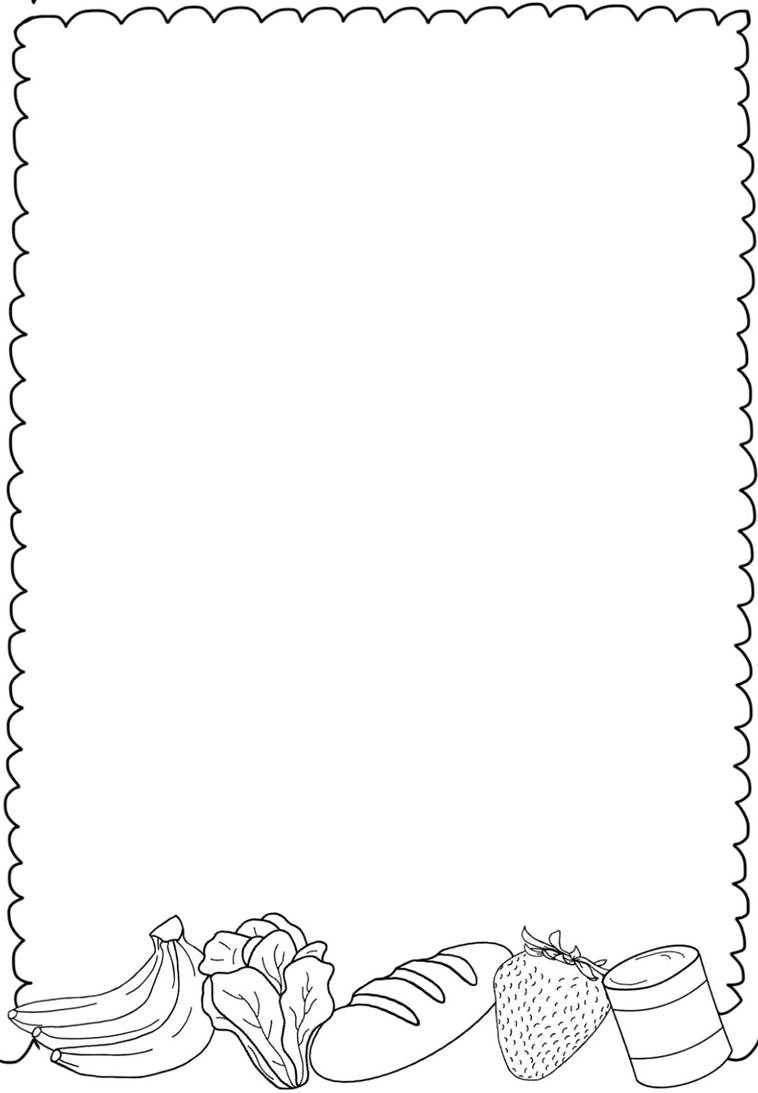
Children should be taught to eat the thick part of the first course along with the liquid; Cutlets, fish, boiled vegetables, as well as pasta or vermicelli are recommended to be divided into small parts. Cucumbers and tomatoes are served sliced, fruits (oranges, tangerines) are peeled. It is advisable to cut hard-boiled eggs in advance and serve them on bread in the form of sandwiches. Children of older groups eat cutlets, fish, boiled vegetables, separating small pieces with the edge of a fork; They cut their own tomatoes and cucumbers, peel hard-boiled eggs and fruits themselves.
Cultural food skills improve with age. Children should be able to use cutlery correctly, eat independently, and carefully. In the senior and preparatory groups, children are given a full cutlery set (knives should not be sharp). Children should be able to use a knife and fork correctly, holding it in both their right and left hands.
The bread is served cut into thin pieces (20-25 g). Children are taught to take it from the bread bin, touching only one piece.
During meals, children sometimes ask for water to wash down their food. This request must be granted, since liquefaction makes food easier to swallow.
With properly organized nutrition, children eat willingly, with pleasure, and do not lose their appetite.
In the nursery group
The nanny is setting the table. When the food is brought, the teacher takes 2-3 children into the toilet and washes their hands. After washing hands, the child goes to the group room, sits down at the table and immediately begins to eat. The dishes are served beautifully presented, not hot, but not cold either. Children who have not developed the skill of eating independently are fed additionally.
After thanking the adults, the kids, as they finish their meal, go to play or get ready for bed.
2nd junior group
At the beginning of the year, the nanny sets the table. In the second half of the year, canteen duty is introduced. Four children are on duty every day, and sometimes more, depending on the number of dining tables (there is one person on duty at each table). Before introducing duty, the teacher organizes a special lesson in which he shows and explains in detail all the actions, involving children in their implementation.
The attendants serve with the help of an assistant teacher: they lay out napkins, lay out spoons for the first and second courses, and place bread bins with bread. By supervising the work of those on duty, the teacher consolidates the skills of arranging equipment, teaches consistency in performing actions, accuracy, and diligence.
As the children eat the dish, the junior teacher removes the salad bowls from the tables; children begin to eat the first course; upon completion, the junior teacher removes the plates from the tables from under the first teacher; the second course is served; The meal ends with the third course. At the end of the meal, the children thank the adults and leave the table.
Middle group
In the middle group, each attendant serves one table.
At the beginning of the year, whoever wants to is on duty. When everyone has learned to be on duty, you can offer the children a duty schedule.
Children, together with the teacher and his assistant, begin to master table setting skills, that is, they are on duty in the dining room, put on specially sewn aprons and set the table.
The attendants lay down individual napkins, place plates (prepared in advance by the teacher's assistant), each opposite a high chair, place spoons and forks to the right of them, and place a glass with napkins in the middle of the table. The cups are placed so that the handle is on the right side.

In the second half of the year, knives appear in table settings for the first time, and the skill of handling them has not yet been developed.
If a knife is served for lunch, it is placed to the right of the plate with the blade facing the plate, next to a spoon, then a salad fork. The fork for the second one is on the left side of the plate.
A small spoon - in a saucer or next to a plate parallel to the edge of the table, the handle of the spoon should be on the right.
When the tables are set, soup is poured for those on duty before other children. Thus, those on duty are usually the first to finish lunch, after which they can begin their duties.
After eating, each child moves his plate to the middle of the table, stacking it on top of others, and takes the cup and saucer to the serving table. At the same time, it is important to ensure that children do not linger near the serving table and create chaos there. This will not happen if children are accustomed to folding dishes neatly.
The attendants remove bread bins and glasses with napkins from the table. Sweeping crumbs off the table.
Senior group
In the older group, the process and amount of work become more complicated. At the beginning of the year there are the same number of people on duty as in the middle group. From the second half of the year, 2 children are assigned to canteen duty.
The attendants come in early, wash their hands, put on aprons, headscarves or caps and set the table completely according to the number of children.
Dishes are offered by delivery. From delivery to the table, children place one item at a time.
Children place the necessary dishes and lay out the cutlery on the right side (spoons and knives on the right, forks on the left). Knives are safe for children with a dull blade. Children from the older group should be able to use cutlery correctly. When all the children’s work is finished, the assistant teacher pours out the prepared food. The children sit down to eat, and at the table the teacher talks with them about what they are eating, what this dish is made from, and what is healthy in it.
In part, children clean up after themselves. After eating, each child moves his plate to the middle of the table, stacks it on the others (if the assistant teacher did not have time to remove it), and takes the cup and saucer to the serving table (saucers on a stack, and cup on a tray).
The attendants must clear dishes, napkin holders, bread bins, and sweep away crumbs from the table.
The children thank the officers on duty for the help they provided.
Children themselves must firmly know the order of their duty and begin it without reminders.
Having thanked the adults, the children of the older groups wait for their table mates, and then leave the table in an orderly manner.
Preparatory group
In the preparatory group, those on duty pass the baton of duty in the evening, but they can be assigned for a whole week.
Starting in January, those on duty agree among themselves who will do what. One covers napkins, lays out spoons and forks, the other puts napkin holders, glasses, lays out knives, etc.
The work of the dining room attendants includes full table setting and cleaning after meals. The most appropriate organization of cleaning would be one that combines the work of the attendants and each child.
For example, after eating, each child moves his plate to the middle of the table, stacking it on top of others, and the cup is taken away. The attendants take away napkins, forks, spoons, bread plates, and wipe the tables. The teacher also teaches children to thank those on duty for the service provided and treats them with respect for their work.
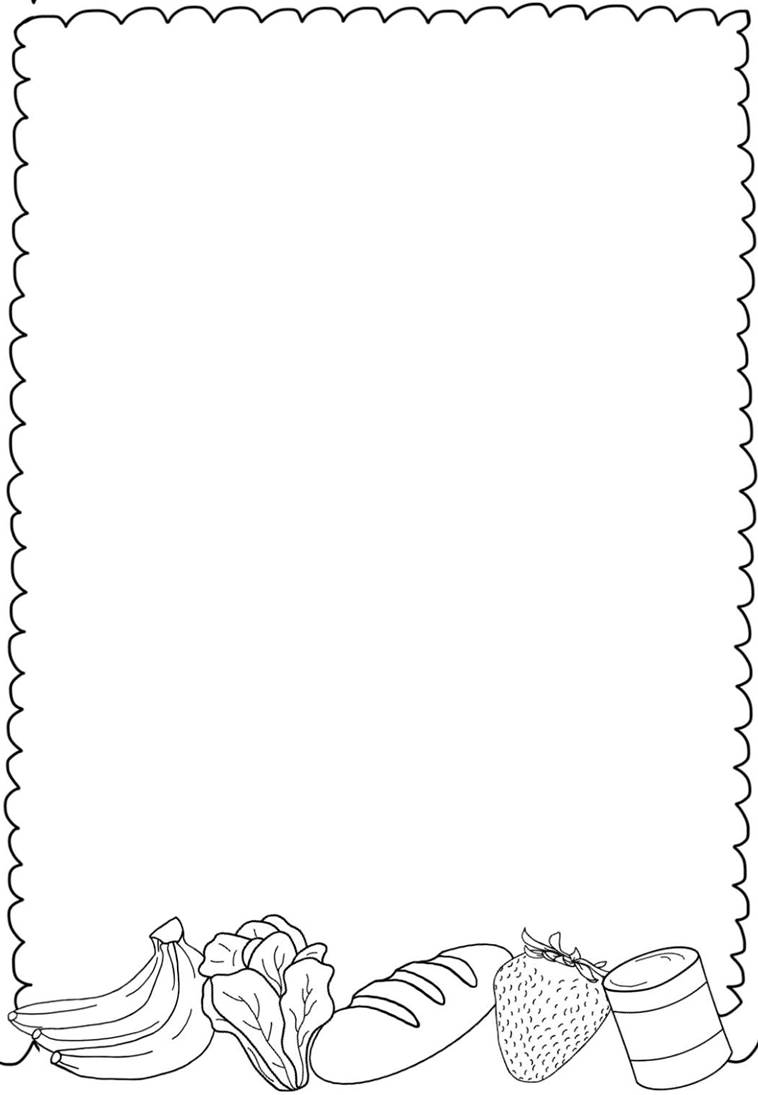
According to the results of nutrition control in December
In 2019, the commission developed recommendations and proposals for organizing meals in groups for teachers and teaching assistants:
1. Educators of all age groups continue to work on developing eating habits and developing cultural and hygienic skills in children, according to the age characteristics of their group.
2. For older groups, depending on the menu, use the necessary cutlery every day when eating: forks, knives.
3. When setting tables every day, use napkins and place salads in separate dessert plates.
4. From middle age, the activities of those on duty should be organized and systematic.
5. Every day, before meals, have conversations with children about the composition and benefits of the dishes that are served.
2. Continue to work on interaction with the families of pupils on this issue.
Diet
The number of meals depends on the length of time the child is in kindergarten and his age. For children staying in a preschool institution for more than 8 hours, four meals a day are provided.
- First breakfast – from 8:00 to 9:00
- Second breakfast – from 10:30 to 11:00
- Lunch – from 12:45 to 13:45
- Afternoon tea - from 15:00 to 15:30
If children stay in kindergarten for more than 12 hours, the number of meals increases. Added to the standard mode:
- Dinner – from 17:30 to 18:30
- Second dinner – from 20:00 to 21:00
During the second dinner, fermented milk products are mainly used.
Legal basis.
The issue under consideration is regulated by Section XV of SanPiN 2.4.1.3049-13, approved by post. GGSV Russia dated 05.15.13 No. 26.
So, in accordance with paragraph 15.1 of the Requirements for the formation of a menu for preschoolers, food fully provides children with the needs of the body.
For this purpose, nutritional standards for dishes offered in groups have been adopted.
The range of dishes offered depends on the composition of the premises used for cooking and the presence of special refrigeration devices (refrigerators) in them.
Some preschool educational institutions practice delivery of food from factories and other catering organizations.
However, overpacking food is not allowed in accordance with established rules.
Menu for children prone to allergic reactions
Due to hereditary factors, environmental conditions and the quality of food products, some children have a tendency to allergies. A child’s fragile immune system is not always able to cope with the aggressive influence of the external environment. Such children need a separately developed menu using hypoallergenic products.

Before admission to kindergarten, the child undergoes an examination at a medical organization, as a result of which the parents are issued a certificate reflecting the child’s health status and the possibility of his developing hypersensitivity to certain foods. This document is provided to the kindergarten, on the basis of which a separate menu is developed for a child with allergies. Preschool institutions can also organize special groups for children with a tendency to allergies. Developing individual nutrition for such children is the responsibility of the kindergarten, regardless of the availability of specialized groups for children with hypersensitivity.
Is it possible to give my child homemade food in kindergarten?
How to organize meals for a child with food allergies in kindergarten? The chairman of the commission for quality control and catering in educational organizations of the City Expert Advisory Council of the Parent Community of Moscow, Natalya Anpetkova, tells the story.
Useful Mela newsletter twice a week: Tuesday and Friday
SUBSCRIBE
Question.
My child has food intolerance and cannot eat many foods. It's sprinkled all over regular borscht from kindergarten. But he loves kindergarten very much. Can I cook food for him and give it to him?
Answer.
Until recently, the answer to this question would have been “alas, no.” However, from January 1, 2022, sanitary rules SanPiN 2.3/2.4.3590-20 came into force (see paragraphs 8.2; 8.2.1; 8.2.2 and 8.2.3).
In Moscow, three preschool institutions in different districts have been opened for children in need of therapeutic and dietary nutrition. In addition, according to clause 8.2.3, in general educational organizations with preschool groups, conditions have been created for providing meals for children with ready-made homemade meals provided by parents
Moreover, even if there is only one child in the kindergarten with such a problem, the educational institution is obliged to create conditions for that particular child to eat. Moreover, it must be equipped according to the same rules as a similar room in a regular kindergarten group.
Clause 8.2.3. SanPiN 2.3/2.4.3590-20 prescribes: “In an organization that provides meals to children in need of therapeutic and dietary nutrition, children are allowed to eat ready-made homemade meals provided by the children’s parents in the dining room or specially designated rooms (places) equipped with tables and chairs, a refrigerator (depending on the number of children eating in this form) for temporary storage of ready-made meals and food products, microwave ovens for heating meals, and conditions for washing hands.”
How to organize individual meals for a child in kindergarten?
- Visit medical specialists (pediatrician, allergist, gastroenterologist, nutritionist, etc.) and obtain a medical certificate or conclusion with the doctor’s prescriptions, and allergenic foods that are excluded from the child’s diet should be listed in detail.
- Write an application addressed to the director of the educational institution, which includes a preschool department, and attach a medical certificate to the application.
- Notify the teacher of the group your child attends.
The employee responsible for organizing meals will contact the parents and discuss the entire algorithm for organizing meals with home-cooked dishes.
It is important that the child’s documents indicate the validity period of the child’s diet. The fact is that the employee who will be responsible for organizing meals for such children is not a medical professional. He must strictly follow the recommendations and deadlines specified in the medical certificate.
The lack of free space in a kindergarten should not be an obstacle to providing children with home-cooked meals for medical reasons. If there is a corresponding application from parents or guardians (legal representatives) and a medical certificate, the educational complex is obliged to find resources and create conditions for organizing such meals.
An educational organization does not have the right to refuse such an application, since the new sanitary rules (SanPiN 2.3/2.4.3590-20) are the law. That is, this rule is now valid throughout the Russian Federation.
For all questions, Moscow parents can always contact the City Expert Advisory Council of the Parent Community under the Department of Education and Science of the City of Moscow. The issue will be resolved immediately.
Mel has a special newsletter for parents of preschoolers! “Pants with Straps” are 16 letters from psychologists and educators, doctors and other experts. Subscribe if you and your child are preparing for first grade.
Photo: Shutterstock/Hanna Rusina
Eating
The process of nutrient absorption is influenced by a number of factors: appetite, the appearance of the dish, the mood of the children, the room used for eating.
The routine in kindergarten is organized in such a way that active games, physical and intellectual exercise are completed 20-30 minutes before meals.
The teacher teaches children to calmly take their places at the tables. Any comments and recommendations during meals are pronounced in a friendly, calm voice.
Meals are taken in clean, well-ventilated areas. Tables and chairs are arranged in a way that is comfortable for children, so as not to impede their movements.
Table setting is important. It is recommended to use dishes that are pleasing to the eye and the same for each child. Tableware should be comfortable and appropriate for the age of the children. The table surface is covered with a clean tablecloth or children are given individual dinner napkins.
During their stay in a preschool, children are taught the rules of using cutlery and behavior at the table. Teachers teach children to keep tables clean and tidy. Depending on the age of the children, the number of cutlery and the serving of dishes vary. In younger groups, fruits, vegetables and eggs are distributed chopped and peeled; children use only a fork and spoon. In preparatory groups, children themselves peel boiled eggs, cut vegetables, and learn to hold a knife in their right hand and a fork in their left hand.
With proper organization of children's nutrition in kindergarten, children eat food with appetite , learn table manners, which is necessary in later adult life.
Essay
Catering in preschool institutions
Introduction
Among the activities aimed at improving the health of children attending preschool institutions, one of the first places is occupied by rational nutrition. The physical development of children, their performance, the state of immunological reactivity, and the level of morbidity largely depend on how clearly and correctly the nutrition is structured in a preschool institution.
rational nutrition preschool immunological
1. Building nutrition in preschool educational institutions
Meals in preschool institutions should be based on the age, length of stay of children in the institution, and their state of health. Most children are in the institution from 9 to 12 hours, but some children attend groups with round-the-clock stays, and their meals during the week are fully provided by the preschool institution. There are sanatorium preschool institutions for children with tuberculosis intoxication, minor and subsiding forms of tuberculosis, where nutrition plays a leading role in the organization of medical and health work. In recent years, preschool institutions have widely organized groups for frequently ill children, for whom proper nutrition is also of no small importance.
Due to the different needs of children under 3 years of age and older for basic nutrients and energy, food sets recommended for preschool institutions are built taking into account this age division. Special sets of products have been developed for sanatorium preschool institutions to provide weakened children with the necessary nutrients. According to the existing regulations, nurseries and nursery groups of nursery-kindergartens must accept children starting from the age of two months. When organizing nutrition for children in the first year of life, it is necessary to strive to maintain breastfeeding as much as possible, to promptly introduce juices, vitamins, and various types of complementary foods into the child’s diet; if there is a lack of breast milk, provide the child with the most rational mixed or artificial feeding, take into account the individual characteristics of the child, his state of health, and systematically monitor the compliance of the diet with his physiological needs for basic nutrients.
Each child in the first year of life should be prescribed individual nutrition, determining the required number of feedings, the volume of food, and its composition. At least once a month, and if necessary, more often, the chemical composition of food should be calculated, the amount of proteins, fats, and carbohydrates actually received by the child per 1 kg of body weight should be determined, and appropriate adjustments should be made. For this purpose, in infant groups, nutrition record sheets should be kept for each child under the age of 9 months, in which the doctor writes down the prescribed food, and the teacher notes the amount of food actually received by the child for each feeding.
Children aged 1-3 years receive nutrition in accordance with the age-related capabilities of the digestive system. Single and daily amounts of food should correspond to the recommended values for children of this age. Culinary processing of food should be gentle, without the use of spicy and fried foods.
For children from 1 to 1.5 years old, it is advisable to have a separate menu that provides for appropriate chemical and mechanical processing, which uses pureed, pureed, steamed dishes.
When drawing up menu layouts, you should take into account the daily set of products required for children of different age groups with different lengths of stay in the institution, the number of children, the volume of each dish, as well as the cost of the daily diet. It is recommended to create a 10-day menu, which allows you to achieve a sufficient variety of dishes. When composing a promising menu, you should multiply the daily amount of products by 10 days, and then distribute them into separate days, taking into account nutritional value and calorie content. To create equivalent menus, it is convenient to use a card index of dishes, which indicates the set and quantity of products, portion yield, chemical composition, and the cost of each individual dish. In the absence of any products, you can easily replace one dish with another of equal nutritional value.
Children staying in a preschool institution for 9-10.5 hours receive three meals a day, providing 75-80% of the daily ration. In this case, breakfast should be 25% of the daily calorie content, lunch - 35-40%, afternoon snack - 15-20%. Children staying in preschool for 12 hours should receive four meals a day. In this case, the calorie content of the afternoon snack does not exceed 10-12%, and the calorie content of dinner is 20-25%. In some preschool institutions, when children stay for 12 hours, three meals a day are practiced, since parents take many children home a little earlier, and they do not have time to have dinner at the institution. In this case, the afternoon snack is made more calorie-rich (up to 25-30% of the daily calorie content). When staying in a preschool around the clock, children receive four meals a day and, in addition to the afternoon snack, fruit.
Children's menus should include a wide range of salads from raw vegetables (for children under 2 years of age, pureed), fresh herbs, fruits (daily), as third courses, give fresh or canned juices and fruit purees for baby food. It is advisable that children receive two vegetable dishes and only one cereal dish during the day. For the second course, it is recommended to prepare combined side dishes from a selection of various vegetables.
2. Meal times in preschool educational institutions
In a preschool institution, it is necessary to strictly adhere to the diet, not to allow deviations from the established meal times by more than 10 - 15 minutes, which largely depends on the smooth functioning of the catering department.
It is very important to correctly build a diet for children in the younger group, where children who have one or two naps during the day can be raised. In this case, life in the group should be structured so that the feeding hours of these subgroups do not coincide.
In the proper organization of nutrition for children, especially young children, the environment in the group is of great importance. Children must be provided with appropriate utensils; comfortable to sit at the table. Dishes should be served beautifully presented, not too hot, but not too cold. Children should be taught to be clean and tidy at the table. Teachers should be calm and not rush children. When feeding children, you should follow the sequence of processes, and do not force children to sit at the table for a long time waiting for the next dish. Children who have finished eating can leave the table and engage in quiet games. Those who cannot feed themselves well must be fed additionally. However, children with poor appetite should not be force-fed. They can be offered a small amount of water, berry or fruit juice during meals to wash down solid food. In some cases, these children can be given a second course first so that they eat the more nutritious, protein-rich food first, and then given some soup. Under no circumstances should children be distracted while eating with toys, reading fairy tales, etc.
3. Continuity of nutrition in preschool educational institutions and at home
To properly organize the nutrition of children in a preschool institution, it is necessary to ensure continuity between food in the institution and at home, to ensure that the child’s home diet becomes an addition to the nursery. For this purpose, children's groups should post recommendations for parents on how to feed children in the evening, on weekends and holidays. At the same time, specific advice is given on the composition of home dinners, taking into account what foods the children received during the day. It is rational to structure meals on weekends and holidays for young children in such a way that they do not differ too much from meals in a preschool institution, since children of this age are quite conservative in their habits.
In the summer, especially when going to the country, children's lives are associated with increased energy expenditure due to increased physical activity, long walks, hard work, etc. In this regard, caloric intake in the summer should be increased by approximately 10 - 15%. This is achieved by increasing the amount of milk and dairy products, mainly through fermented milk drinks, as well as vegetables and fruits. In the summer, children should widely include fresh herbs in their diet - dill, parsley, lettuce, green onions, garlic, sorrel. Fresh vegetables and herbs not only make dishes richer in vitamins, but also give them an attractive appearance and pleasant taste, which is especially important in hot weather, when children’s appetite may decrease. Taking into account the latter circumstance, in the summer it is recommended to change the diet, replacing lunch with a second breakfast (at the expense of an afternoon snack). Lunch is moved to a later time, after naps. This diet in the summer is especially rational in the republics of Central Asia and Transcaucasia, where the air temperature is especially high at midday.
In summer, children's need for fluid increases significantly. Therefore, the group should always have a supply of fresh boiled water or rosehip infusion. Drinks should be offered to children after returning from a walk, before water procedures; on especially hot days, you can give a drink before meals. During walks, especially long excursions, children should also be provided with some kind of drink. For this purpose, teachers, when going on an excursion, must take with them a supply of boiled water and cups according to the number of children.
4. Catering in sanatoriums
The organization of nutrition for children in sanatorium preschool institutions (groups) has some features. The additional amount of food products included in the set for preschool institutions of this type allows you to significantly diversify the menu, introduce additional dishes into it, expand the range of vegetable dishes, and widely include seasonal vegetables, including fresh herbs, in children's diets. It is better to use vegetables raw to prepare salads, which can be served not only for lunch, but also for breakfast and dinner. Fruits and berries, the quantity of which is also increased, can be given fresh or in the form of juices, mousses, jellies, added to lunch as a dessert, as well as for an afternoon snack or dinner.
Due to the increase in the number of dairy products in sanatorium institutions (groups), it is recommended to increase the number of meals by prescribing a glass of milk, kefir or any other fermented milk drink before bed. Cottage cheese for these institutions can be obtained from dairy kitchens, which will allow it to be given to children without heat treatment for breakfast or afternoon snack. At the same time, it should be emphasized that cottage cheese obtained from food bases must necessarily be subjected to heat treatment. It can be used to prepare casseroles, puddings, cheesecakes, etc.
5. Drawing up a menu for children with health problems
In preschool institutions, a certain proportion of children have some deviations in health (allergic mood, chronic diseases of the liver and biliary tract, excess or lack of body weight, etc.). The nutrition of such children is tailored individually, taking into account the existing pathology.
The organization of nutrition for children newly admitted to the institution, as well as children returning after an illness, also requires great attention. In some cases, these children, as well as children with health problems, require individual nutrition, taking into account their level of development, health status and existing skills.
To sufficiently provide children with vitamins, preschool institutions provide for year-round C-vitaminization of food. The first or third courses are usually fortified (at the rate of 35 mg for each child under 3 years of age), the vitamins are dissolved in a small amount of the liquid part of the dish and poured into a cauldron removed from the heat. A special journal on C-vitaminization of food is kept in the catering department of a preschool institution. A nurse or other employee of the institution, in whose presence C-fortification of food is carried out, daily notes in it the name of the fortified dish, the number of servings, the total amount of ascorbic acid administered, and the time of fortification. C-fortification of food in children's institutions should be carried out regularly, without allowing breaks even during the summer-autumn period, when food products are richer in vitamins.
As scientific research conducted in recent years has shown [Spirichev V.B., 1984; Ladodo K.S., Spirichev V.B., 1986; By Thi Duc Tho et al., 1987], even with properly organized nutrition of children, their need for vitamins is not sufficiently satisfied, including in the summer-autumn period. This gave grounds to propose additional multivitaminization of children in preschool institutions using multivitamin preparations (“Hexavit”). Additional multivitaminization is primarily recommended for children with unsatisfactory somatic status (lagging behind in physical development, often ill, with decreased appetite), as well as children raised in round-the-clock groups who have a significant deficiency of vitamins C, group B, PP, A. B During the period of spread of acute respiratory diseases, additional multivitaminization is recommended for all children. Multivitaminization should be carried out for a long time - at least 4 months (mainly in the winter-spring period).
It is recommended to begin multivitaminization of children in a favorable epidemiological situation from the end of November - beginning of December, in case of an influenza epidemic, an outbreak of acute respiratory viral infections - from the moment the threat of the spread of diseases arises (from September-October). Multivitamin preparations (“Hexavit”) are given to children during breakfast or lunch every other day (Monday, Wednesday, Friday) 1 tablet. The duration of taking the drugs is at least 4 months. If indicated (seasonal rise in respiratory diseases), multivitaminization can be extended for 1-2 months. When carrying out additional multivitaminization of children, C-vitaminization of nutrition does not stop.
Conclusion
Organizing children's nutrition is a difficult, but at the same time important moment in the development of a child. Because it can both prevent and treat many nutritional diseases and other types of diseases.
When organizing meals, you should take into account a complex of various factors, such as:
·Age
·Geographical position
·Individual tolerance
The relationship between nutrition in preschool educational institutions and nutrition at home
And also a number of other, no less important factors, since proper nutrition must fully meet the individual requirements of the child’s body.
Bibliography
1. Tamova M.Yu., Zaiko G.M., Shamkova N.T., Zlobina N.V. Approximate Shamkova N.T., Zaiko G.M., Podloznaya V.I., Tamova M.Yu.
2. Scientific and practical principles of organizing meals for students in educational institutions / Textbook. Krasnodar: KubSTU Publishing House, Publishing House-Yug LLC, 2007. 208 shifts for organizing children’s meals in preschool educational institutions / Monograph. Krasnodar, 2009. 136 p.
3. Magazine “Medical care and catering in preschool educational institutions” Article: Technological maps of recipes for first courses
4. Journal “Medical care and catering in preschool educational institutions” Article Guidelines for heads of educational institutions implementing a preschool education program for monitoring the provision of comprehensive nutrition services
Tags: Catering in preschool institutions Abstract Pedagogy
Child's refusal to eat
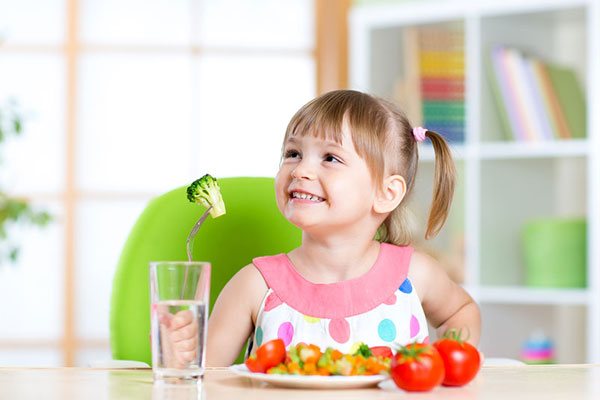
While in kindergarten, a child may refuse to eat for several reasons:
- Adaptation. The first days in preschool are the most difficult for a child. Stress caused by an unusual environment is a natural reason for refusing to eat. The eating regime will improve after some time, when the child gets used to the new conditions.
- Disease. Loss of appetite may be caused by the development of the disease. A doctor's consultation may be required to determine the cause.
- Some children have an insufficient level of self-care. In this case, you need the help of a teacher who can teach the child how to use cutlery.
Kindergarten menu for 14 days.
The nutrition of children is approved by the head of the preschool institution. The document is a menu designed for 14 days.
The list of dishes should contain proteins (up to 15%), fats (up to 30%), carbohydrates (up to 55%) in the total value of the diet.
In addition, when compiling this list, national preferences and the peculiarities of the territorial representation of cuisine, as well as the health of minors, are taken into account.
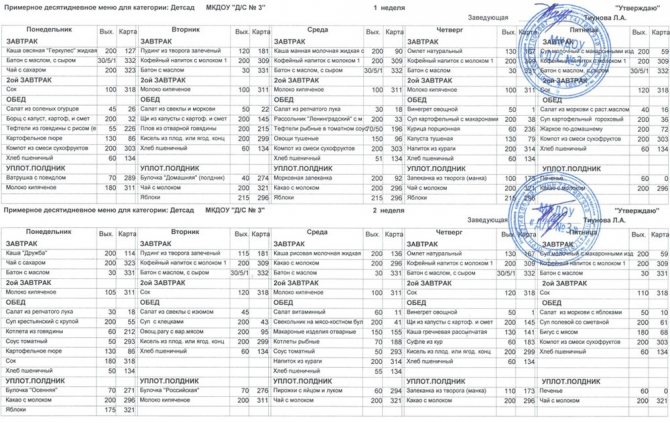
Drawing up an assortment of dishes requires a clear distribution of calorie content within the day.
Thus, separate meals must be planned taking into account its energy value.
More detailed information about the diet in kindergarten is given in the summary table below.
| Preschool visit form | Time | Approximate caloric value, % |
| Constant | breakfast | 20 |
| 2nd breakfast | 5 | |
| dinner | 30 | |
| afternoon tea | 15 | |
| dinner | 25 | |
| before bedtime | 5 | |
| 10 o'clock | breakfast | 25 |
| 2 breakfast | 5 | |
| dinner | 35 | |
| afternoon tea | 15 | |
| 12 o'clock | breakfast | 25 |
| lunch | 5 | |
| dinner | 35 | |
| afternoon tea | 15 | |
| dinner | 20 |
If children stay in a preschool educational institution for twelve hours, afternoon snacks and dinner can be replaced with a compacted afternoon snack with an energy value of 30-35 percent of the daily value.
The decision is made by the kindergarten administration taking into account the current situation.
Organizing child nutrition at home
Homemade meals for a preschooler must be organized in accordance with the meals in kindergarten. Uncontrolled consumption of food by a child is unacceptable, since excess intake of calories into the body can provoke excess weight gain and the development of pathologies of the endocrine, cardiovascular system and musculoskeletal system. In order to properly organize your child’s home nutrition, it is important to study the kindergarten menu every day and prepare homemade food based on the type and quantity of products already used.
On holidays and weekends, it is also recommended to adhere to the kindergarten regime, this way it will be easier for the child to adapt and form the habit of eating regularly.
The more developed a child’s nutritional skills are, the more successful his future life will be. The ability to eat according to the regime and needs of the body is the key to good health.
Nutrition for preschoolers: how to feed a child aged 3-7 years
From birth, the baby receives nutrients along with food that form his immune system and ensure normal development. In preschool age, proper nutrition is also very important so that the child can endure school stress comfortably in the future, be healthy and active.
Most children aged 3 to 7 years spend most of their time in kindergarten, which is responsible for organizing a balanced diet in accordance with age. Follow the principles of rational nutrition
you also need at home:
Important: strict adherence to diet!
- the menu should be varied;
- nutrition should supply the child’s body with energy, microelements, vitamins and other useful substances;
- products must be properly processed and prepared (boiled, steamed, stewed, baked).
In order for a child to grow up active, mobile and healthy, it is important for parents to provide their menu with essential nutrients.
and make sure you have enough
calories
:
| 3 years | 4-6 years | 7 years | |
| Energy, kcal | 1540 | 1970 | 2350 |
| Proteins, g | 53 | 68 | 77 |
| Fats, g | 53 | 68 | 79 |
| Carbohydrates, g | 212 | 272 | 335 |
| Where are they kept? | |
| Squirrels | Animal proteins: meat, fish, milk and dairy products, eggs. Plant proteins: bread, cereals, legumes, vegetables |
| Fats | Butter and vegetable oil, milk and dairy products, meat, fish |
| Carbohydrates | Sugar, fruits, confectionery |
In addition to the above beneficial substances, the child should receive microelements and minerals
. They are responsible for the proper development and functioning of the entire body.
Table of the average daily physiological requirement of the body for basic micro- and macroelements
| Name | Function | Source (products containing the element) | Daily value for children 3-7 years old |
| Calcium | Formation of bones and teeth, blood coagulation systems, processes of muscle contraction and nervous excitation. Normal heart function. | Milk, kefir, fermented baked milk, yogurt, cheese, cottage cheese. | 800-1100 mg |
| Phosphorus | Participates in the construction of bone tissue, the processes of storage and transmission of hereditary information, and the conversion of the energy of food substances into the energy of chemical bonds in the body. Maintains acid-base balance in the blood. | Fish, meat, cheese, cottage cheese, cereals, legumes. | 800-1650 mg |
| Magnesium | Synthesis of protein, nucleic acids, regulation of energy and carbohydrate-phosphorus metabolism. | Buckwheat, oatmeal, millet, green peas, carrots, beets, lettuce, parsley. | 150-250 mg |
| Sodium and Potassium | They create conditions for the occurrence and conduction of nerve impulses, muscle contractions and other physiological processes in the cell. | Table salt is sodium. Meat, fish, cereals, potatoes, raisins, cocoa, chocolate - potassium. | Not exactly established |
| Iron | A component of hemoglobin, the transport of oxygen by blood. | Meat, fish, eggs, liver, kidneys, legumes, millet, buckwheat, oatmeal. Quince, figs, dogwood, peaches, blueberries, rose hips, apples. | 10-12 mg |
| Copper | Necessary for normal hematopoiesis and metabolism of connective tissue proteins. | Beef liver, seafood, legumes, buckwheat and oatmeal, pasta. | 1 - 2 mg |
| Iodine | Participates in the construction of thyroid hormone, ensures physical and mental development, regulates the state of the central nervous system, cardiovascular system and liver. | Seafood (sea fish, seaweed, seaweed), iodized salt. | 0.06 - 0.10 mg |
| Zinc | Essential for normal growth, development and puberty. Maintaining normal immunity, sense of taste and smell, wound healing, absorption of vitamin A. | Meat, groats, eggs, cheese, buckwheat and oatmeal. | 5-10 m |
Sufficient amount of vitamins
in the daily children's diet is the key to the proper functioning of all vital processes.
Vitamins are practically not synthesized by the body itself, so parents must always ensure that they are supplied to the child in sufficient quantities with food. At the same time, their insufficient quantity can cause a number of diseases.
Table of the average daily physiological requirement of the body for essential vitamins
| Name | Function | Products containing vitamin | Daily value for children 3-7 years old |
| B vitamins | |||
| IN 1 | Necessary for the normal functioning of the nervous system, cardiac and skeletal muscles, and gastrointestinal tract organs. Participates in carbohydrate metabolism. | Wholemeal bread, cereals, legumes (peas, beans, soybeans), liver and other by-products, yeast, meat (pork, veal). | 0.8 - 1.0 mg |
| AT 2 | Maintains normal properties of the skin, mucous membranes, normal vision and hematopoiesis. | Milk and dairy products (cheese, cottage cheese), eggs, meat (beef, veal, poultry, liver), cereals, bread. | 0.9 - 1.2 mg |
| AT 6 | Maintains normal skin properties, nervous system function, and hematopoiesis. | Wheat flour, millet, liver, meat, fish, potatoes, carrots, cabbage. | 0.9 - 1.3 mg |
| AT 12 | Supports hematopoiesis and normal functioning of the nervous system. | Meat, fish, offal, egg yolk, seafood, cheese. | 1 - 1.5 mcg |
| PP (niacin) | Functioning of the nervous and digestive systems, maintaining normal skin properties. | Buckwheat, rice groats, wholemeal flour, legumes, meat, liver, kidneys, fish, dried mushrooms. | 10-13 mg |
| Folic acid | Hematopoiesis, growth and development of the body, synthesis of protein and nucleic acids, prevention of fatty liver. | Wholemeal flour, buckwheat and oatmeal, millet, beans, cauliflower, green onions, liver, cottage cheese, cheese. | 100-200 mcg |
| WITH | Regeneration and healing of tissues, maintaining resistance to infections and poisons. Hematopoiesis, permeability of blood vessels. | Fruits and vegetables: rose hips, black currants, sweet peppers, dill, parsley, potatoes, cabbage, cauliflower, rowan, apples, citrus fruits. | 45-60 mg |
| A (retinol, retinal, retinoic acid) | Necessary for normal growth, development of cells, tissues and organs, normal visual and sexual function, ensuring normal skin properties. | Liver of sea animals and fish, liver, butter, cream, sour cream, cheese, cottage cheese, eggs, carrots, tomatoes, apricots, green onions, lettuce, spinach. | 450-500 mcg |
| D | Participates in the processes of calcium and phosphorus metabolism, accelerates the absorption of calcium, increases its concentration in the blood, and ensures deposition in the bones. | Butter, chicken eggs, liver, fat from the liver of fish and sea animals. | 10-2.5 mcg |
| E | Antioxidant, supports the functioning of cells and subcellular structures. | Sunflower, corn, soybean oil, cereals, eggs. | 5-10 mg |
Thus, the diet of a preschool child should include all food groups.
Diet
It is best to prepare a menu for a child several days in advance, so parents can make sure that it is varied and contains the necessary nutrients.
Here is a sample menu for children from 3 to 7 years old for a week
:
| Day of the week | Breakfast | Lunch | Dinner | Afternoon snack | Dinner | Second dinner |
| Monday | Buckwheat porridge with milk Coffee drink with milk Bread with cheese | Juice or fruit | Salad Shchi with sour cream Meatballs with pasta Dried fruit compote Bread | Kefir Cookies | Carrot-apple casserole Milk tea Bread | Fermented milk product |
| Tuesday | Baked fish with vegetables Mashed potatoes Coffee drink with milk Bread and butter | Juice or fruit | Vitamin salad Vegetable soup Homemade roast Apple jelly Bread | Milk Crackers Apple | Curd casserole Tea with milk Bread | Fermented milk product |
| Wednesday | Rice porridge with milk Coffee drink with milk Bread and cheese | Juice or fruit | Beetroot-apple salad Peasant soup Meat cutlet Boiled cauliflower Milk jelly | Yogurt Cookies Apple | Omelette Stewed cabbage Tea Bread | Fermented milk product |
| Thursday | Macaroni with grated cheese Coffee drink with milk Bread and butter | Juice or fruit | Green pea salad Beetroot goulash with buckwheat porridge Dried fruit compote | Tea Cheesecake with cottage cheese Apple | Vegetable stew Boiled egg Milk Bread | Fermented milk product |
| Friday | Hercules milk porridge Boiled egg Coffee drink with milk Bread and butter | Juice or fruit | Carrot-apple salad Borscht with sour cream Fish balls Boiled potatoes Kissel | Ryazhenka Cookies Fruit | Curd cheesecakes with sour cream Tea with milk Bread | Fermented milk product |
| Saturday | Barley milk porridge Coffee drink with milk Bread with cheese | Juice or fruit | Cabbage-apple salad Rassolnik Boiled rice with vegetables and meat Fruit jelly | Kefir Crackers Fruits | Pancakes (pancakes) with jam Milk | Fermented milk product |
| Sunday | Fish in Polish Boiled potatoes Coffee drink with milk Bread and butter | Juice or fruit | Carrot salad Chicken broth with croutons Boiled chicken with rice and stewed beets Rosehip broth Bread | Milk Homemade bun Apple | Vegetable casserole Tea with milk Bread | Fermented milk product |
How to teach your child proper table manners?
From the age of 3, it is time to teach your child to behave properly at the table. First of all, this will save him from difficulties with nutrition in kindergarten.
- The child should sit straight at the table and not put his elbows on the table.
- Teach your child to properly hold and use a spoon, fork, and drink carefully from a cup.
- The child should chew food thoroughly, chew with his mouth closed, and not talk while eating.
- Teach your child to first check if the food or drink is too hot, and to blow on the food if it is hot.
- While eating, the child should not be distracted by TV or toys. The child should be in a calm state.
- Teach your child etiquette: saying “thank you,” getting up from the table when he is allowed to, and washing his hands before eating.
And remember: your personal example in everything is the main thing!







